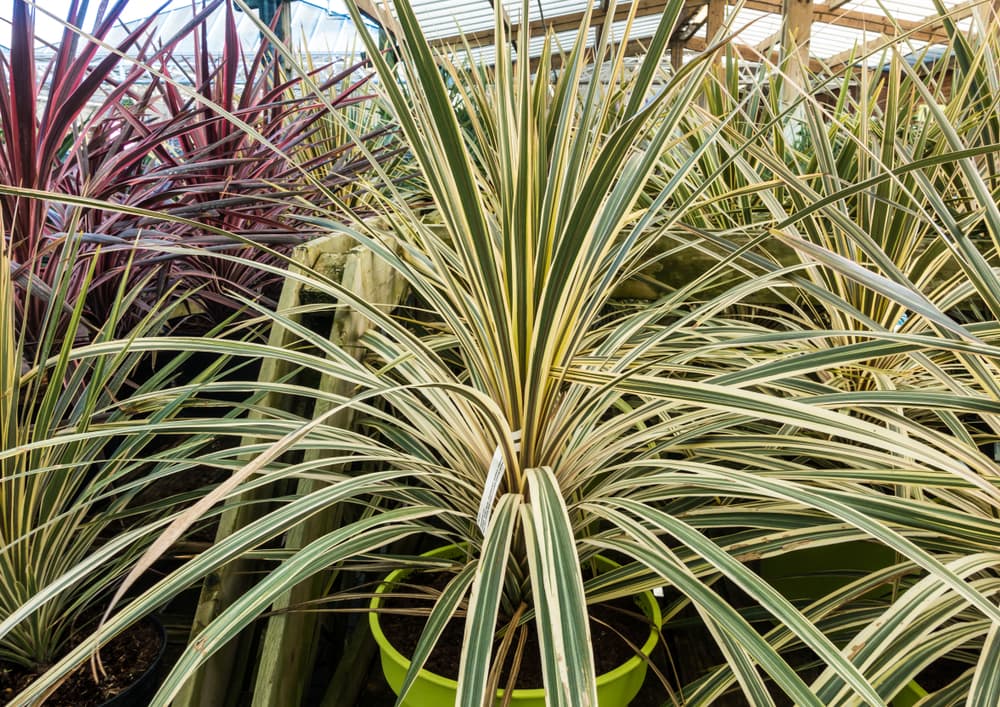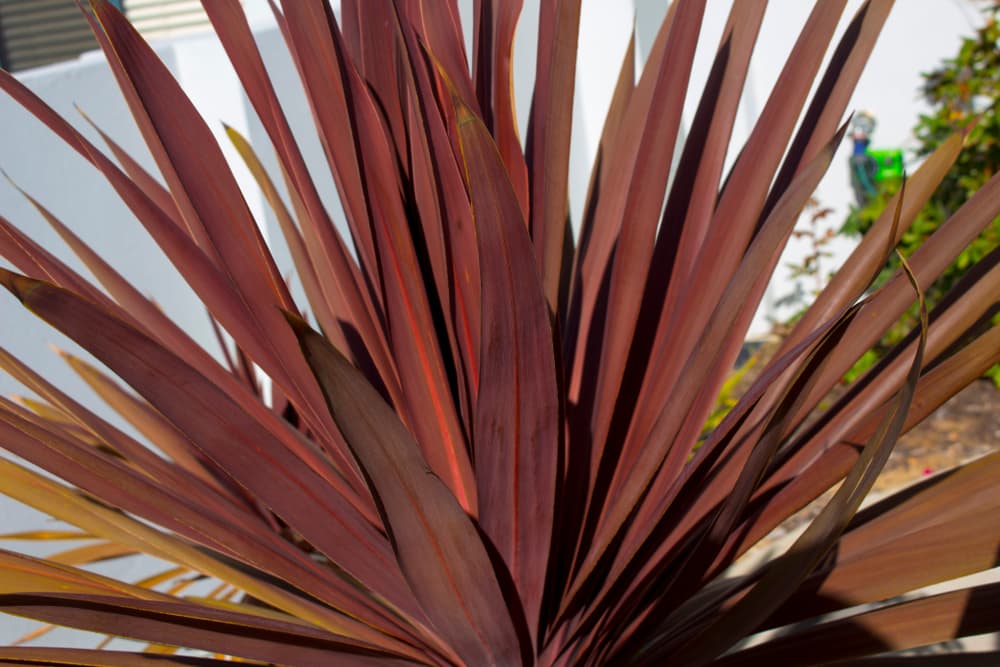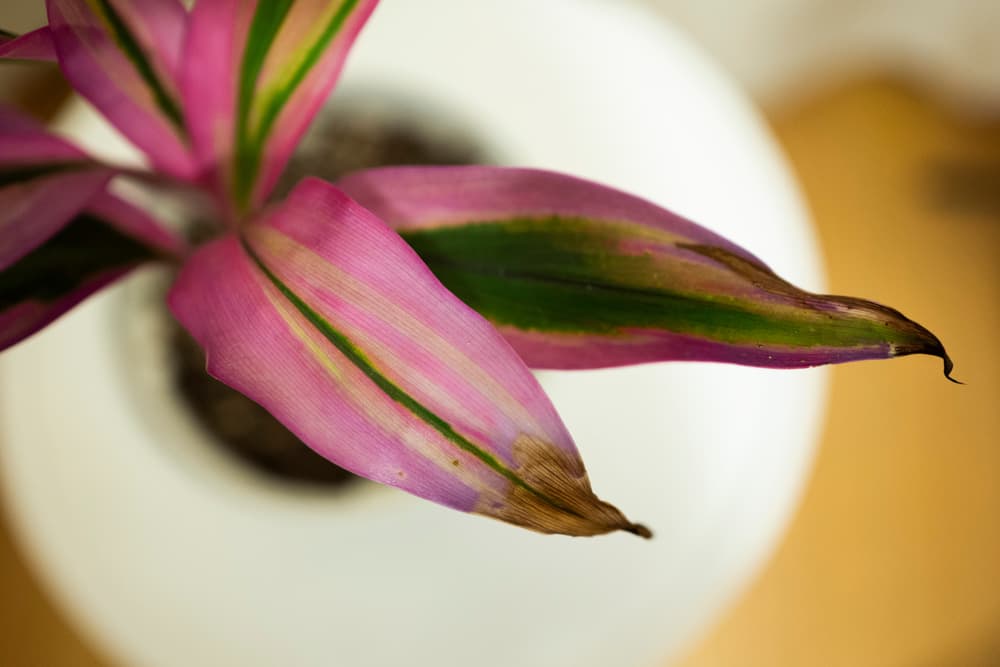SHRUBS > CORDYLINE
Reviewed By PETER LICKORISH

Peter is a Horticulture Lecturer and self-employed Horticulturist, with a passion for diverse areas of the industry - from garden design to the science behind plant growth and propagation. He has completed the Royal Horticultural Society’s Master of Horticulture (MHort) Award and lectures on RHS courses at Bedford College.
IN THIS GUIDE
Although Cordyline is a genus comprising 23 species of woody plants, where gardeners are concerned the name connotes a handful of ornamental species.1Cordyline Comm. ex R.Br. (n.d.). Kew Botanic Gardens. Retrieved May 22, 2023, from https://powo.science.kew.org/taxon/urn:lsid:ipni.org:names:24159-1#children
They are of widely varying sizes, most with lanceolate leaves fanning outward radially and bearing clusters of tiny flowers.
The ‘Cabbage Tree’ and its variants are perhaps the most well-known and also the most popular species.
Cordyline species are fairly diverse in both size and appearance.
Many Cordyline are a good choice for borders and for accents, they are used to set off brightly-coloured flowers, and they make artistic elements in a rock garden.
Overview
| Botanical Name | Cordyline |
| Common Name(s) | Cabbage Palm |
| Plant Type | Shrub |
| Native Area | Eastern Australia, New Zealand & Melanesian Islands |
| Hardiness Rating | H3 (for species grown outdoors in the UK) |
| Foliage | Leathery leaves in a lance shape |
| Flowers | Fragrant cup-shaped flowers |
| When To Sow | April, May |
| Flowering Months | June, July, August |
Sunlight
Preferred
Full Sun / Partial Shade
Exposure
Sheltered
Size
Height
4 – 8M
Spread
2.5 – 4M
Bloom Time
July – August
Soil
Preferred
Most Soil Types
Moisture
Moist but well drained
pH
Any
They can be placed in the corners of your patio, and they can just as well be placed in the corners of your drawing room.
“How happy they are outside, and for how long, will depend on their hardiness,” shares Master Horticulturist Peter Lickorish.
“Those with a hardiness of H1 are predominantly houseplants.”
Cordyline are evergreen perennials and many of them resemble miniature palm trees.
The leaves tend to be lance-shaped and pointed, radiating outward, and growing in tiers on the central stem.

They are among the most distinctive and striking of all leaves.
While many are some shade of deep green, other species’ and cultivars’ foliage have eye-catching hues.
Young leaves of some species are hot pink, others are bordered and striped with yellow and rose, still others are a chocolatey maroon.

But Cordyline is not only about its attractive foliage: in summer, most species bear panicles or other sprays of small white or light-coloured flowers.
These are adored by bees.
Come autumn, the panicles and sprays transform into tassels of small berries, usually red and sometimes purple.
Because Cordylines are perennials and, once planted in conditions to their liking, require very little care, they are an excellent choice for the casual gardener who wants to plant once, especially outdoors, and then leave the little beauties to their own devices.
Cordyline Plant Care
In the main Cordyline cultivars prefer moist but well-drained soil and a humid atmosphere.
While you certainly should not overwater, do not allow the soil to dry out especially during summer, dry weather, or the growing season.
Preferred Sunlight

These plants’ preference for sun or shade varies quite widely between even related species.
C. australis does best in full sun to very light shade but C. fruticosa prefers part shade, with indirect sunlight being best.
As a general rule, species and cultivars with green leaves have a greater preference for sun; in contrast, the more multi-coloured the foliage, the greater the preference for shade and indirect sunlight.
Soil & Fertilising
Most Cordyline plants do best in rich soil.
Cordylines have a distinct preference for moist soil and do not do well in dry soil.
Some Cordylines do well even in wet soil but it should not be waterlogged, especially in winter, when their tolerance for dampness is at its lowest.
The soil’s pH should be between slightly acidic to neutral; a good range is 6.0-7.0.

“If potting your plant, use commercial organic soil or a mix comprising close to 50% loam and the rest peat-free compost, with some added grit,” adds Peter.
Choose a fertiliser with a balanced N-P-K ratio with which to fertilise potted Cordyline at monthly intervals during the growing season.
“Those grown in the ground rarely need feeding, though mulching before winter can be beneficial,” Peter says.
Do not fertilise at all during winter.
Habitat & Growing Conditions
Cordyline species, as multifarious as they are, thrive in diverse conditions.
Take the Cabbage Tree itself – they can grow in soil conditions ranging from low-lying swamps to rocky hillsides in New Zealand where they once covered vast tracts of land including riverine areas.
In contrast, C. congesta or the Narrow-Leaved Palm Lily sprout next to rainforests and within eucalyptus forests.

Other Cordylines thrive in river valleys. However, what is non-negotiable for seedlings and young plants is ample sunlight and abundant water.
Cordyline species, as tropical and sub-tropical plants, prefer warm climates.
Even so, most Cordylines are right at home in distant lands like England and Japan where they are sought-after architectural plants.

These evergreens are surprisingly hardy; indeed, some species and cultivars tolerate even sub-freezing temperatures.
Consider: though the preferred temperature range for both C. australis and C. australis ‘Atropurpureum’ is 18-22°C, the former can tolerate temperatures all the way down to -7°C and the latter to -5°C provided the plants are mature.
How To Shorten A Cordyline
Where Cordylines are concerned, your watchword is, “be merciless!” – and that’s because Cordylines can get out of hand and grow tall, gangly and straggly, but they are very forgiving of the knife.
Simply – and mercilessly – cut back the entire plant to reduce and control its size during the growing season.
Use a pair of secateurs or loppers (after cleaning the blades with diluted rubbing alcohol) to cut off one or more heads and leave about 40cm of the main stem(s).
Fresh growth will soon be visible, but you can help this along by applying some blood fertiliser or bone fertiliser.
Repeat the process as and when necessary and you will end up with a Cordyline whose size and shape is to your liking.

However, if, after being cut back, the plant has not grown tall but has spread too far laterally or looks unkempt, prune it.
Do not cut off the entire head during the rainy season or in cold weather – during periods of rain or cold, the plant needs its leaves to survive.
“Cordyline trunks are among the most distinctive features of this plant once mature,” shares Peter.
“You can either cut old, dying leaves back to leave short stubs a couple of centimetres long, which make a geometric pattern cloaking the trunk, or peel the leaves off to expose the trunk underneath.
“I can’t decide which I prefer with mine so have done both, but either way, it’s a vigorous plant.
“Scarcely a decade old, mine is several metres high and puts on extensive re-growth each year.
“Growing bolt upright, it makes a good focal point with a slender canopy, ideal for underplanting.”
Common Problems
Aphids, mealybugs, scale, thrips, and spider mites are the main pests and problems that Cordyline owners may need to tackle.
Spider Mites
Be vigilant, especially on indoor Cordylines, as spider mite can cause unsightly brown spotting on the leaves.
This is a result of the mites sucking sap.
If you catch a spider mite infestation early, it may have affected only a small part of your plant.
If so, cut off that part, but if the entire plant is affected, it will be difficult to eliminate the mites and the wisest course may be to give up that plant.
Otherwise use pyrethrum to control populations which have begun to produce silk webbing.
Mealybugs
If your mealybug-infested Cordyline is outdoors, release beneficial insects like lacewings and Mealybug Destroyers on the plant.

They prey upon mealybugs.
“Inside, some levels of damage can be tolerated, but pyrethrum is a successful treatment.
Aphids
Aphids are a serious threat because they breed so rapidly and in such numbers that they can outrun your efforts to exterminate them.
Wipe or spray any major aphid infestations off with water, to prevent secondary problems with sooty mould. They are more likely to be found indoors.
Thrips
To control a localised infestation of thrips, which can severely weaken plants by their sap-sucking, hang suitable sticky traps to minimise damage.
For bigger or stubborn infestations, spray Spinosad once only and not on a recurring schedule.
Also deploy minute pirate bugs and lacewings, the natural predators of thrips.
FAQs
How Long Do Cordylines Live?
C. australis trees in the wild have lived up to several hundred years.
In very good conditions a horticultural plant can live to 50 years.

Cordylines aged 20-plus years are not uncommon in established nurseries.
It takes a few years for a stem cutting to attain an acceptable size and over a decade for Cordyline to develop a trunk and grow into a tree.
How Do You Know When Your Cordyline Is Dead?
You need to be sure that your Cordyline is dead because sometimes they play possum!
If your Cordyline has lost all its leaves, continue caring for it and be patient.
If new shoots sprout from the trunk itself, the plant is not dead.

But if no shoots sprout from the trunk or from the soil level, the plant is probably dead, especially if the trunk or core of the plant feels mushy.
If the main stem or trunk feels soft but firm lower down, cut it back to the point where it is hard and firm – do so only in the summer.
Then keep a watch on the plant to see whether or not new shoots sprout from the remainder of the trunk.
References
- 1Cordyline Comm. ex R.Br. (n.d.). Kew Botanic Gardens. Retrieved May 22, 2023, from https://powo.science.kew.org/taxon/urn:lsid:ipni.org:names:24159-1#children


